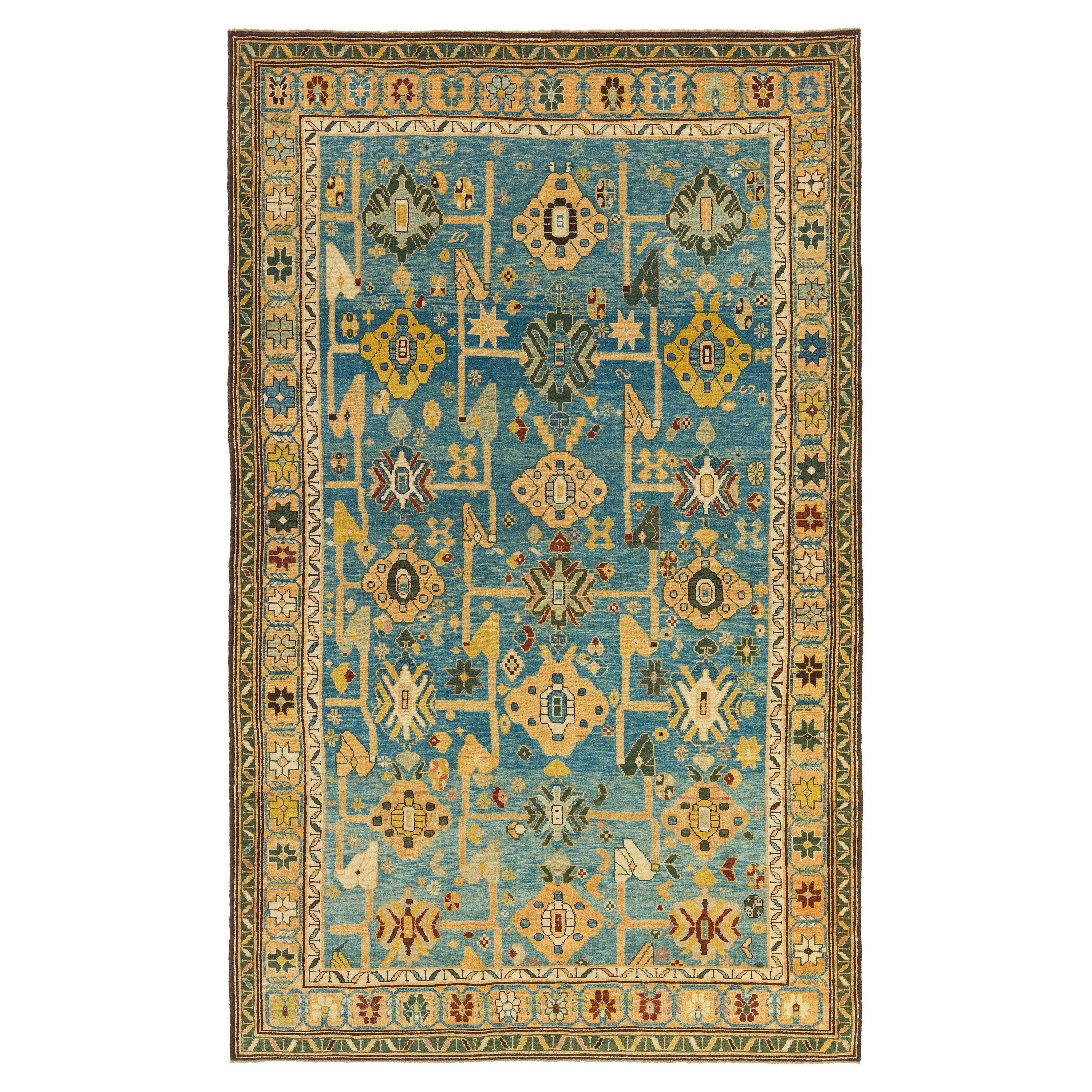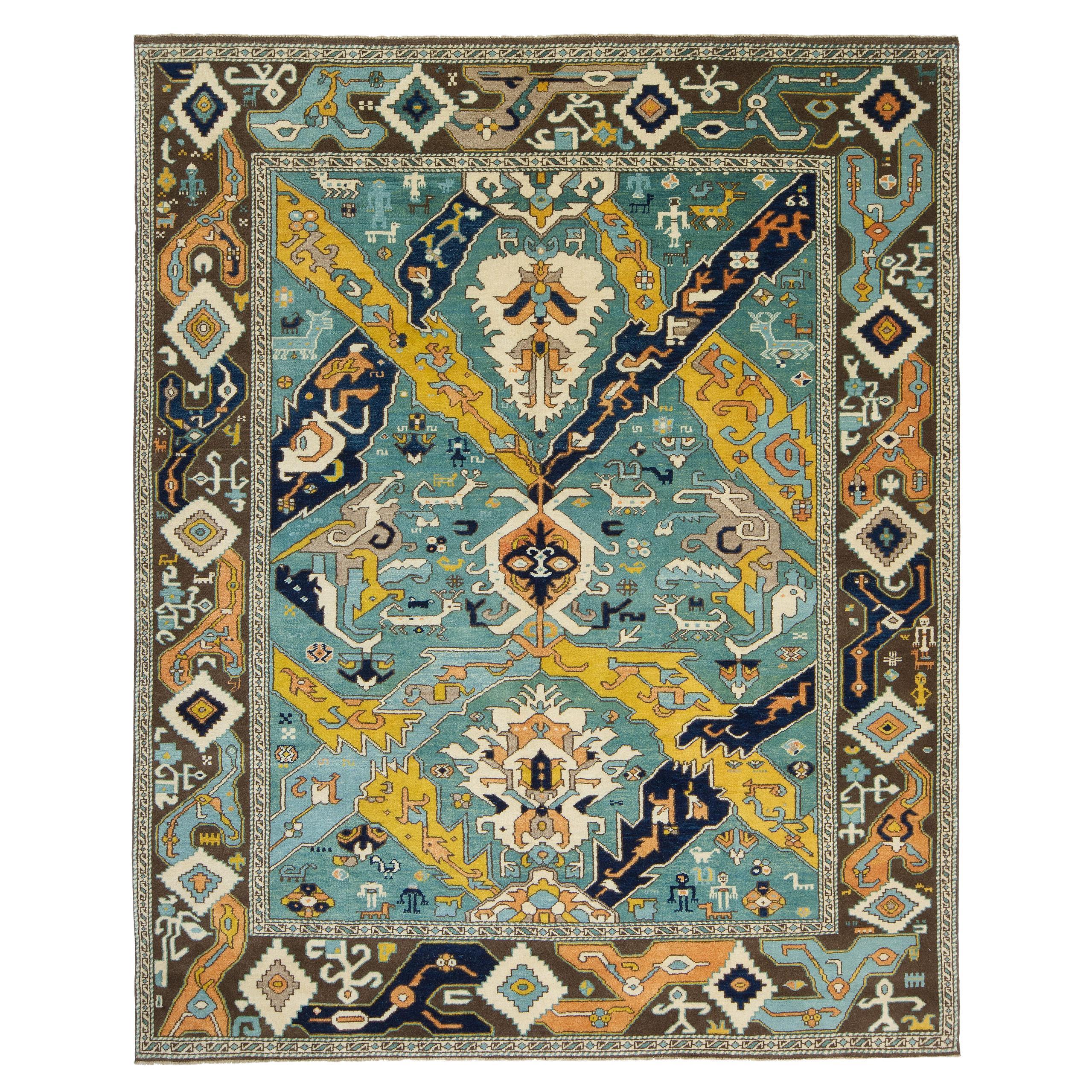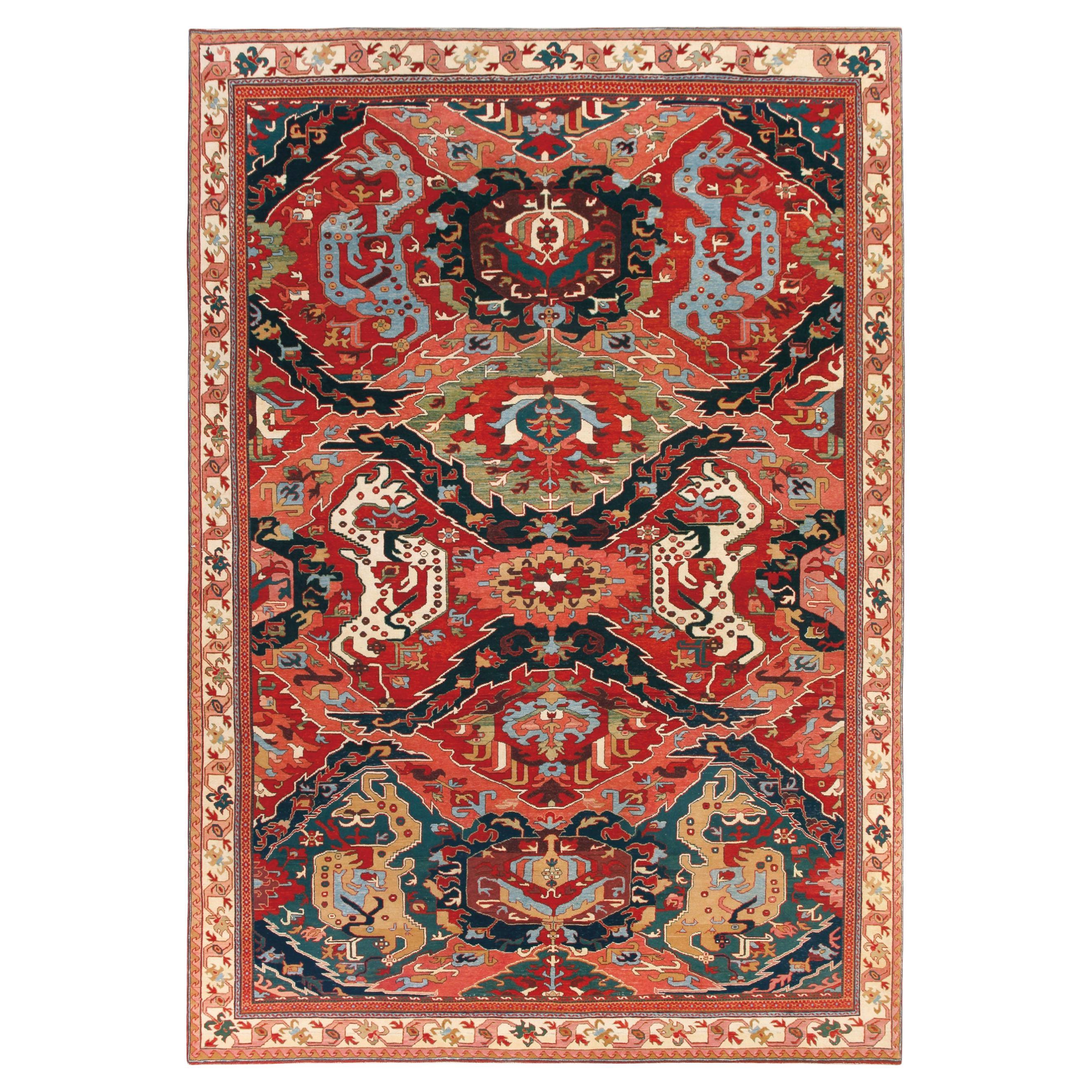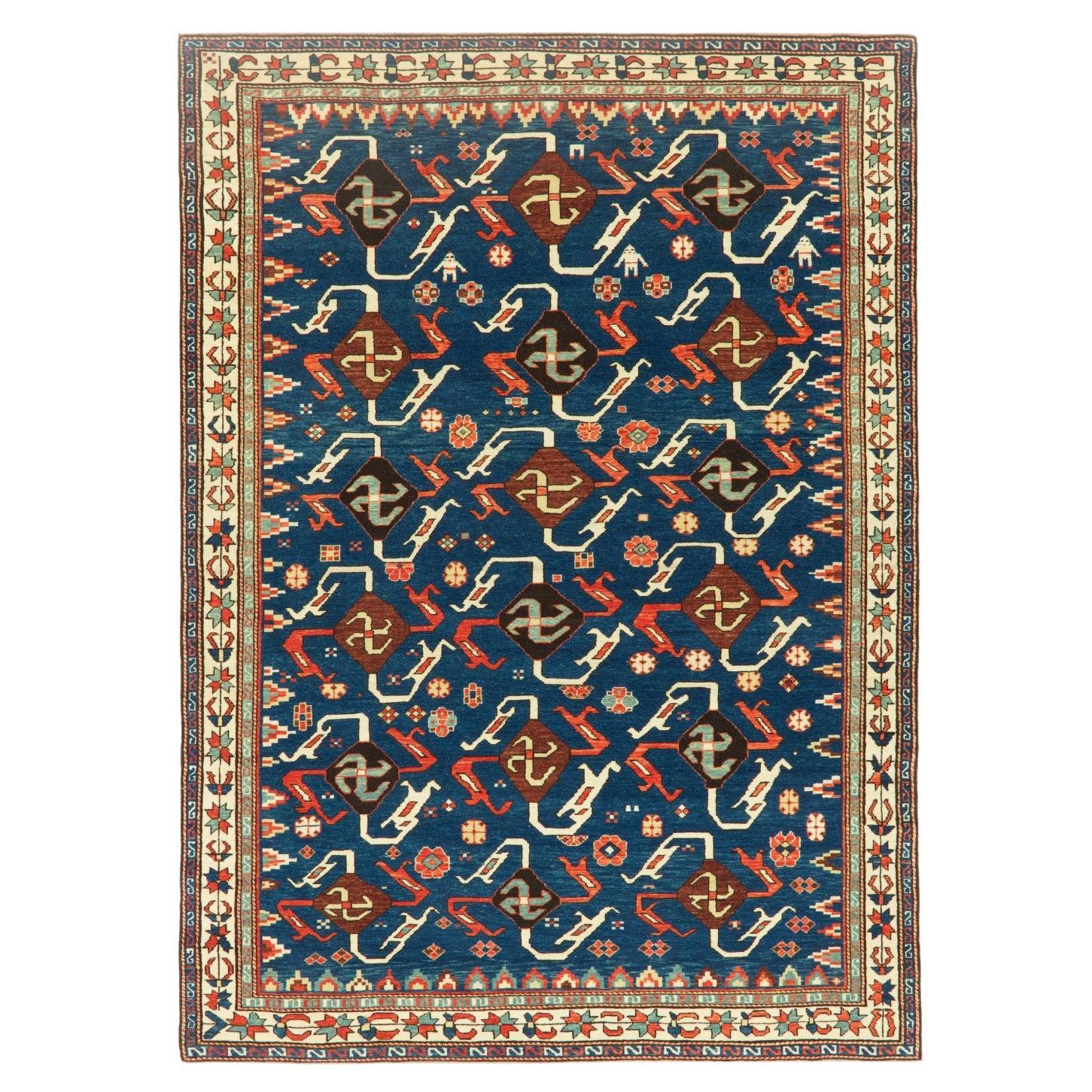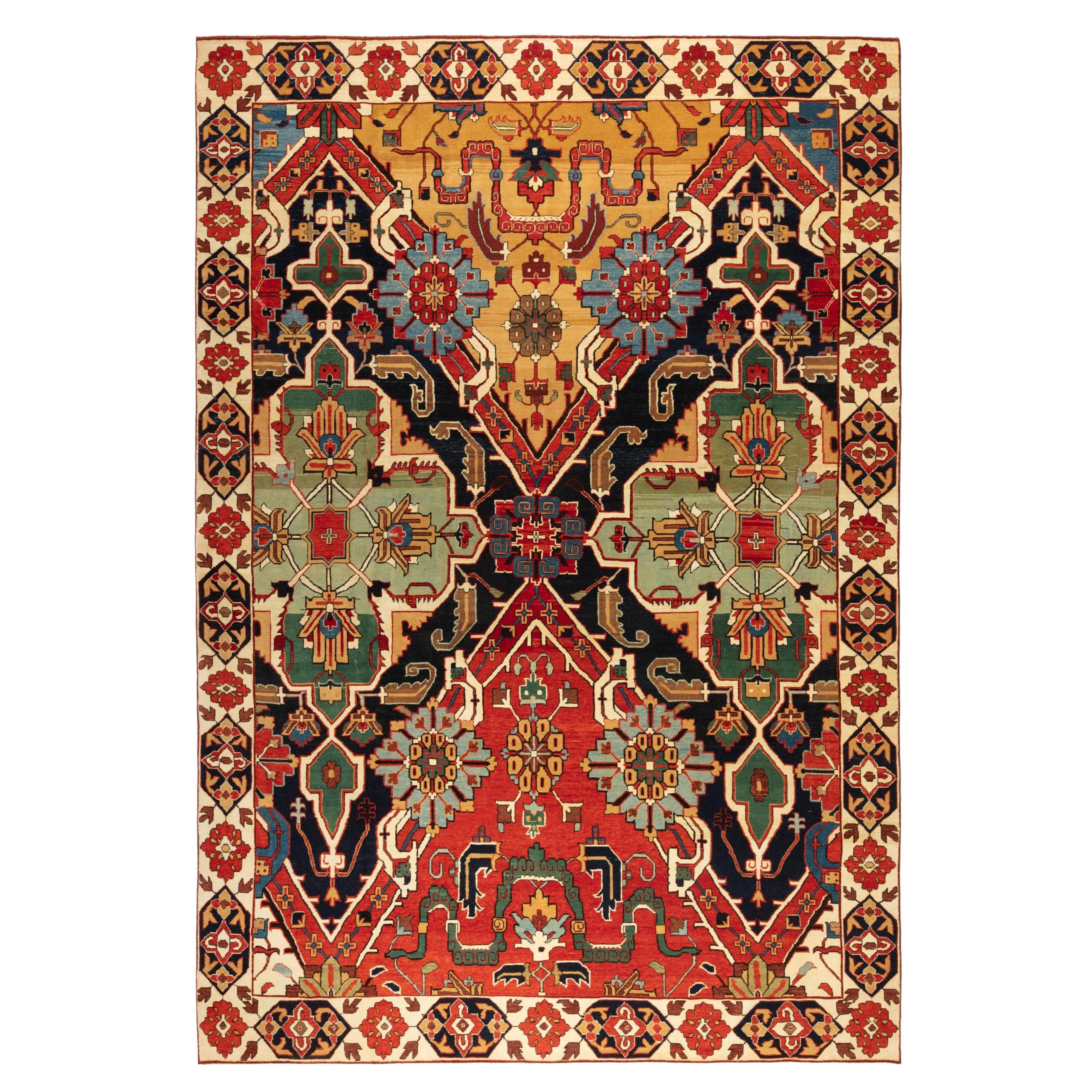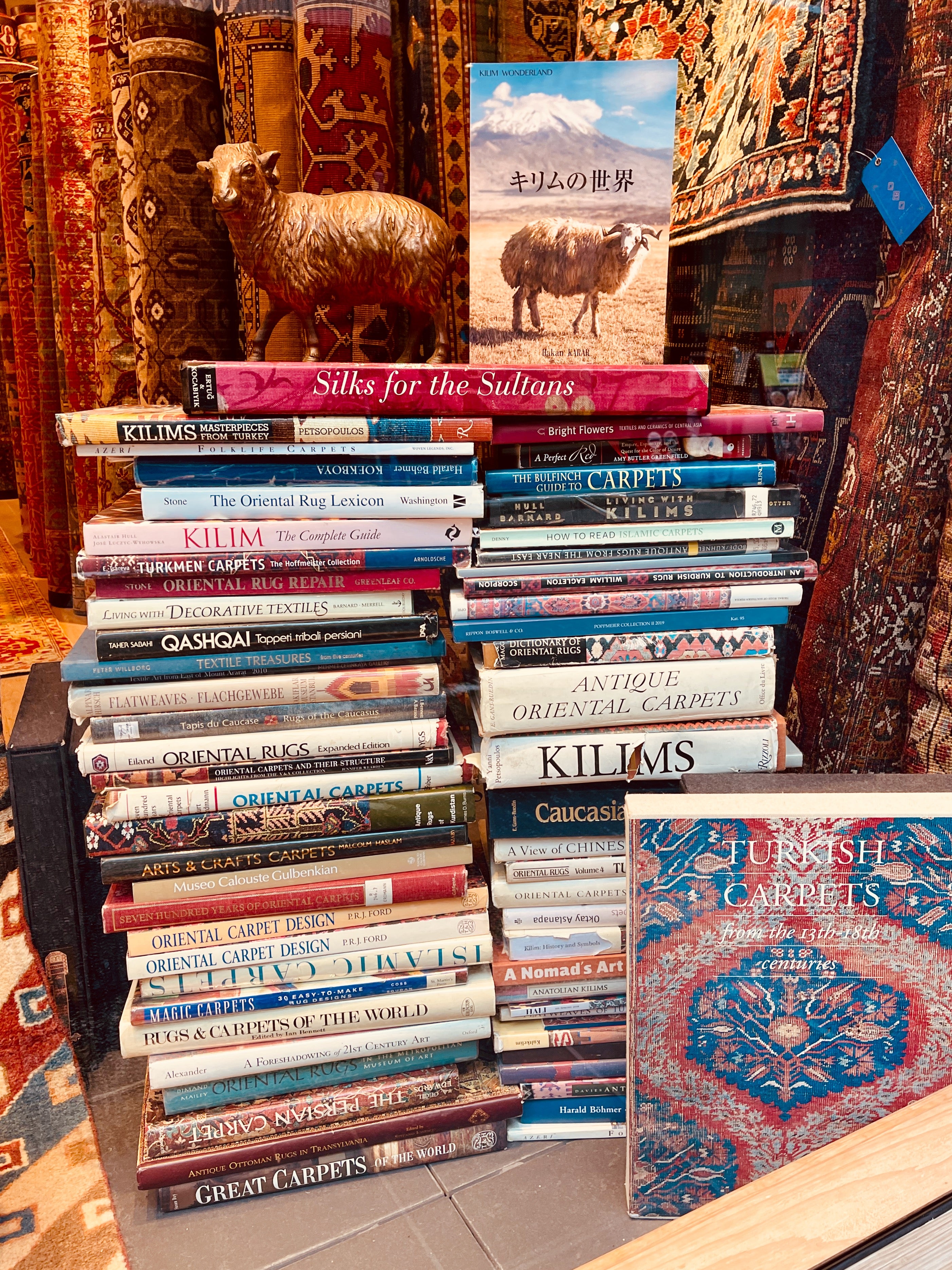Items Similar to Ararat Rugs Mina Khani Karabagh Rug, Caucasus Revival Carpet, Natural Dyed
Video Loading
Want more images or videos?
Request additional images or videos from the seller
1 of 6
Ararat Rugs Mina Khani Karabagh Rug, Caucasus Revival Carpet, Natural Dyed
About the Item
The source of the rug comes from the book Oriental Rugs Volume 1 Caucasian, Ian Bennett, Oriental Textile Press, Aberdeen 1993, nr.250-251. This is a floral composition lattice rug from the late 19th century, Karabakh region, Caucasus area. This stylized lattice design, with its flowers, is known as the mina-khani and is found in various forms on the rugs of many tribes in Persia, particularly those of the Kurds and Baluch. The handling of the design on this rug suggests a north Persian/Kurdish origin seems more likely, it is also found on Kurdish and other Persian tribal pieces, especially those from around the Veramin area in north Persia. The design of this rug is interpreted by our designers and soft colors are chosen for this rug.
Color summary: 9 colors in total, most used 4 colors are;
Burlywood 135 (Spurge – Madder Root)
Dark Blue 21 (Indigo)
Mettwurst 541 (Madder Root)
Pale Green 439 (Chamomile – Indigo)
Group: Caucasian Rugs Family
Area: Karabagh region
Material of Pile: Natural Dyed Hand-spun Wool
Material Warp / Weft: Wool on Wool
Structure: Symmetrical knot
Knots Density: 36x29
Production Place: Southeastern Anatolia – Adiyaman Province
Stock Location: Tokyo
Size (EU): 229 X 170cm
Size (US): 7'6" X 5'6"
Area (EU): 3.9m²
Area (US): 41.9ft².
- Creator:Ararat Rugs (Manufacturer)
- Dimensions:Width: 66.93 in (170 cm)Length: 90.16 in (229 cm)
- Style:Revival (In the Style Of)
- Materials and Techniques:
- Place of Origin:
- Period:
- Date of Manufacture:2022
- Production Type:New & Custom(One of a Kind)
- Estimated Production Time:Available Now
- Condition:
- Seller Location:Tokyo, JP
- Reference Number:1stDibs: LU8206232800512
ARARAT RUGS
We know and believe that the geography we come from, our past, and our lifestyle are the most important bond between us to carry the oriental carpet art and culture to the next generations along with our core values in our ongoing growth journey.
We are aware that the way to achieve this goal and carry this priceless art and culture to the future depends on a lot of work with all our people every day while adhering to our core values.
For us, art is meaningful in the sense that it brings together various cultures around the world. It is an honor for us that oriental carpet art and culture have been instrumental in this for centuries and that we are a part of this business.
We are tirelessly keeping an eye on auction house information around the world about carpets. New York's Metropolitan, London's Victoria & Albert Museums, and other famous art museums, as well as small specialized museums that house private collections, and books about oriental carpets to collect information on outstanding carpet designs and patterns from around the world. It's our Self-improving and Self-developing culture.
As Turkish Culture of Hospitality, the Kurdish Culture of Generosity, and as Japanese Culture of Business Punctuality; are the most important values that this multicultural background has taught and bequeathed to us. It is essential and valuable for us that you feel this feeling not only by looking at our oriental carpets but from the moment you contact us.
About the Seller
5.0
Vetted Seller
These experienced sellers undergo a comprehensive evaluation by our team of in-house experts.
Established in 1970
1stDibs seller since 2023
17 sales on 1stDibs
Typical response time: 1 hour
- ShippingRetrieving quote...Ships From: Tokyo, Japan
- Return PolicyA return for this item may be initiated within 7 days of delivery.
More From This SellerView All
- Ararat Rugs Mina Khani Karabagh Rug, Caucasus Revival Carpet, Natural DyedBy Ararat RugsLocated in Tokyo, JPThe source of the rug comes from the book oriental rugs volume 1 Caucasian, Ian Bennett, Oriental Textile Press, Aberdeen 1993, nr.250-251. This is a...Category
21st Century and Contemporary Turkish Revival Caucasian Rugs
MaterialsWool, Natural Fiber, Organic Material
- Ararat Rugs Dragon Rug, Antique Caucasus Museum Revival Carpet, Natural DyedBy Ararat RugsLocated in Tokyo, JPThe source of the carpet comes from the book Hali Magazine 1993 Issue 67, pg.93 and Hali Magazine 1992 Issue 61, pg.61. Peter Bausback, Mannheim, described it on the occasion of his ...Category
21st Century and Contemporary Turkish Revival Caucasian Rugs
MaterialsWool, Natural Fiber, Organic Material
- Ararat Rugs Dragon Rug, Antique Caucasus Museum Revival Carpet, Natural DyedBy Ararat RugsLocated in Tokyo, JPThe source of the rug comes from the book Orient Star – A Carpet Collection, E. Heinrich Kirchheim, Hali Publications Ltd, 1993 nr.57. There has long been a fascination with the symbolism of the dragon and its depiction in carpet weavings. The design of ‘Dragon’ carpets consists of a field pattern composed of different colored overlaid lattices formed of pointed, serrated leaves creating intersecting lozenges, which alternately contain palmettes and are flanked by confronting stylized dragons, birds, or animal figures. The most archaic of the ‘Dragon’ carpets include dragon motifs with birds and running animals relatively naturalistically drawn, which stand either alone or in confronting pairs facing a tree. The Graf carpet, originally found in a Damascene mosque, now in the Islamiches Museum, Berlin, is considered to be the oldest example of this type, see Serare Yetkin, Early Caucasian Carpets in Turkey, Vol. II, London, 1978, p.8, fig.118. Yetkin defines four types of ‘Dragon’ carpet: ‘Archaic’, ‘Four-Dragon’, ‘Dragon-and-Phoenix’ and as a further combined development of the latter, the ‘Two-Dragon’ style, of which the present carpet falls into the ‘Dragon-and-Phoenix group along with other examples, some of which include two fragments, one in the Museum fur Kunst und Gerwerbe, Hamburg; another in the Christian Museum, Esztergom, Hungary, a complete carpet in the Kier collection; an incomplete example in the Textile Museum, Washington, D.C; the ‘Cassirer’ Dragon carpet in the Thyssen-Bornemisza collection, Lugano; the Ali Pasa Mosque carpet in Tokat, and a further example in the Vakiflar Hali Museum, Istanbul (S. Yetkin, op. cit. pp.16-20). It has been suggested that the earliest examples of the Caucasian ‘Dragon’ carpets...Category
21st Century and Contemporary Turkish Revival Caucasian Rugs
MaterialsWool, Natural Fiber, Organic Material
- Ararat Rugs Swastika Design Rug, Antique Caucasus Revival Carpet, Natural DyedBy Ararat RugsLocated in Tokyo, JPThe source of rug comes from the book Orient Star - A Carpet Collection, E. Heinrich Kirchheim, Hali Publications Ltd, 1993 nr.17. This is a remarkable and very unusual swastika designed early 19th-century rug from the Central Caucasia area. This unusual pattern is not known on other rugs but is seen on two Anatolian embroideries...Category
21st Century and Contemporary Turkish Revival Caucasian Rugs
MaterialsWool, Organic Material, Natural Fiber
- Ararat Rugs Nigde Carpet, Antique Caucasus Museum Revival Rug, Natural DyedBy Ararat RugsLocated in Tokyo, JPThe source of the carpet comes from the book Islamic Carpets, Joseph V. McMullan, Near Eastern Art Research Center Inc., New York 1965 nr.41. This rug has become famous as the “Nigde...Category
21st Century and Contemporary Turkish Revival Caucasian Rugs
MaterialsWool, Natural Fiber, Organic Material
- Ararat Rugs Swastika Design Rug, Antique Caucasus Revival Carpet, Natural DyedBy Ararat RugsLocated in Tokyo, JPThe source of rug comes from the book Orient Star – A Carpet Collection, E. Heinrich Kirchheim, Hali Publications Ltd, 1993 nr.17. This is a remarkable and...Category
21st Century and Contemporary Turkish Revival Caucasian Rugs
MaterialsWool, Organic Material, Natural Fiber
You May Also Like
- Fine 19th Century 'Mina Khani' Karabagh CarpetLocated in London, GBAntique Karabagh rugs are much sought after by collectors and designers as they boast some of the oldest and most varied designs of all Caucasian weavings, and represent perhaps the ...Category
Antique 1890s Armenian Kazak Caucasian Rugs
MaterialsWool
- Antique Colorful Caucasian Karabagh Runner, circa 1910s, Mina Khani DesignLocated in New York, NYThe near black ground of this south Caucasian runner shows a narrow section of a formalized Persian Mina Khani rosette trellis pattern with numerous pairs of small animals. Yellow an...Category
Vintage 1910s Caucasian Tribal Caucasian Rugs
MaterialsWool
- Antique Caucasus - KarabaghLocated in New York, NYAntique Caucasus - Karabagh. Measures: 6'8" x 14'8".Category
Antique Early 1900s Caucasian Caucasian Rugs
MaterialsWool
- Antique Caucasian Kazak Rug, Southern Caucasus Mountains, KarabaghLocated in Philadelphia, PAAntique Caucasian Kazak rug, circa 1875. All wool and natural dyes. Very good condition. Sturdy and as clean as a brand new rug (deep washed professionally). Measures: 4'3" x 7'7".Category
Antique Late 19th Century Caucasian Kazak Caucasian Rugs
MaterialsWool
- Antique "Sunburst" or "Eagle Kazak" Rug. Chelaberd, Karabagh, Southern CaucasusLocated in Philadelphia, PAA splendid antique Caucasian rug from the village of Chelaberd in Southern Karabagh. This highly popular so called sunburst or Eagle Kazak design rugs are some of the most collectibl...Category
Antique Late 19th Century Caucasian Kazak Caucasian Rugs
MaterialsWool
- Karebagh Carpet from CaucasusLocated in Alessandria, PiemonteTypical Caucasian rug with a strong personality and a modern style .. Its four polychrome medallions occupy the red field in contrast with the black background. The blue of the fra...Category
Mid-20th Century Caucasian Other Caucasian Rugs
MaterialsWool
